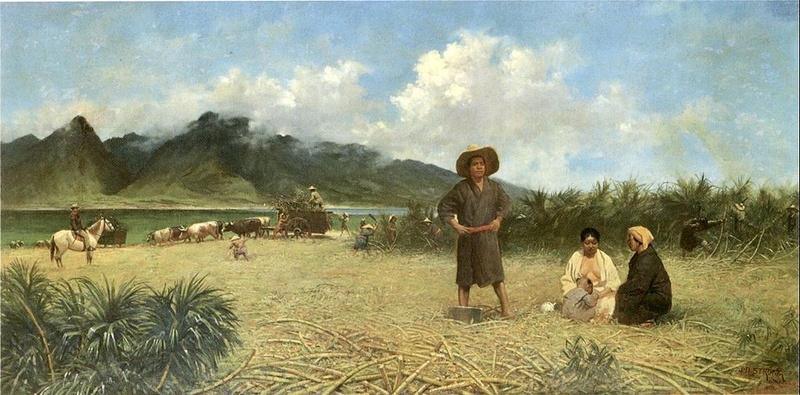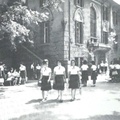There were also Japanese people who had been living in the area since before the Gannenmono
One thing I found interesting while reading "History of Immigration to Hawaii" was the passage that states that when the first Japanese immigrants to Hawaii, the "gannenmono," arrived in Honolulu in 1868 (the first year of the Meiji era), there were already three Japanese people living there.
A letter from Makino Tomisaburo, one of the 150 Gannenmono, announcing his safe arrival at Honolulu Harbor is reproduced on page 12. In it, he writes, "There are no drunks or rowdy people here, and I feel peaceful and happy. When I arrived, there were three Japanese people there. Sentaro, who was from Kanagawa Prefecture, stayed behind to help with translations and advice, and it was as if I had met Buddha in hell."
In "The Grassroots of Japanese Immigrants to Brazil" (1932), a book written by Suzuki Nanju (Suzuki Teijiro), who went to Brazil as an "experimental subject" two years before the Kasato Maru immigration, he introduces two men who were already local Japanese residents and frequented the embassy in Petropolis when he first visited the embassy, as "the original Japanese in Brazil."
One of them was "Grandpa Akiba," a Hawaiian immigrant who had moved there. "He had come from Hawaii to Santos on a British ship, and after moving around a lot, he finally came to Petropolis. Until recently, he had been working as a cook at the embassy, but at that time he was walking around the streets selling goods with a box of sweets on his head and playing a flute that made a sound like a charumera" (PDF version, page 16). This is a story from 1906.
Furthermore, it is said that "Mr. Akiba does not know exactly how old he is, or how many years he has lived in the country," so he was truly like an "international sage."
The other is "Manji the acrobat," also known as "Takezawa Manji," who was introduced in a series titled " Understanding the mystery of acrobat Takezawa Manji = The history of Japanese-Brazilian exchanges as seen through the circus = Part 1 = Landed in around 1870, performed throughout Brazil?. "
I'm sure the three in Hawaii have some interesting stories to tell.
The "Landing Refusal Incident" linked to Shigetsuna Furuya
In addition, the "Landing Refusal Incident" (page 93) caught my eye. "Immigration companies actively recruited immigrants by lending $50 in portable funds to those who did not qualify for contract immigration or those who wanted to immigrate, and devising a loophole to send them off as "free immigrants." The loaned money was then collected after the immigrants landed, a method known as "show money." This led to the Hawaiian government refusing entry to over 1,100 immigrants, claiming that "the source of the portable funds was unclear and unreasonable."
In response, the Japanese government dispatched Counsellor Masanosuke Akiyama of the Ministry of Foreign Affairs to Honolulu on the warship Naniwa in April 1897 to demonstrate a strong stance toward the Hawaiian government. "The Naniwa was accompanied by reporters from the Mainichi, Kokumin, Chuo, Jiji and Mancho newspapers, and the media was also mobilized" (p. 93).
Incidentally, the reporter for the "Kokumin Shimbun" at that time was Shigetsuna Furuya, who was well known as a diplomat in the Brazilian community before the war. However, before he became a diplomat, he was a reporter for the "Kokumin Shimbun" run by Soho Tokutomi.
According to "Biographies of Japanese Pioneers in Brazil" (p. 433, Paulista Shimbun, 1955), when the incident of refusal of Japanese immigrants to land in Hawaii occurred in 1896, Furuya went to Hawaii as a special reporter on the warship Naniwa. He then persuaded the company's owner, Tokutomi Soho, to study law at the University of Michigan, and returned to the Kokumin Shimbun after graduation.
He passed the diplomatic examination in 1902, and after serving overseas, became Director-General of the Ministry of Foreign Affairs' Trade Bureau in 1921. In 1926, he became Ambassador Plenipotentiary to Argentina, Paraguay, and Uruguay. After returning to Japan, he turned down an offer for promotion and emigrated to Brazil in 1929. Furuya's son Tsunamasa was of journalist descent, and became an editorial writer for the Mainichi Shimbun in Japan.
Furuya, a former diplomat who emigrated to the country, ran a banana plantation in Cedro on the Juquia Line. He served as chairman of the Educational Extension Association from 1936 to 1938, but as a leader of the losers' group, he was the first to be attacked by the hard-line faction of the winners' group just after the end of the war. As a former journalist, he was keen to gather information, and even during the war he subscribed to a Japanese newspaper in North America. He explained to Yoshiro Fujita, who worked for Hachiya Shokai at the time, the importance of spreading accurate information in the colonia, and Fujita followed his advice and founded Taiyodo Bookstore in 1949. This is the Taiyodo Bookstore that still stands today in Liberdade Japan Square.
The expulsion of unscrupulous immigration companies and the first sake brewing
The first Japanese elementary school in Hawaii opened in 1896, the year after the Japan-Brazil Treaty of Amity and Commerce was signed. The first Brazilian immigrant ship, the Tosa Maru, was supposed to depart from the Oriental Emigration Company in August 1897, but was canceled at the last minute due to the "coffee crash."
In fact, between 1900 and 1907 alone, just before the Brazilian immigration began in 1908, 71,000 Japanese people came to Hawaii. After being released from the shackles of three years of farm labor, many of them moved to the mainland for better pay, especially in California.
According to page 116, in 1904 alone, 11,132 people migrated from Hawaii to the mainland. Hawaii, where immigration conditions were more lenient than the mainland, served as a springboard. Among them, the number of second-generation Japanese born in Hawaii exceeded the 1,000 mark in 1901, reaching 1,134, and peaked at 3,437 in 1903. They are the forerunners of the Japanese community in Brazil.
It seems that in every country, there are companies that exploit immigrants. "Japanese intellectuals in Honolulu raised criticism against Consul General Saito Kan, who supports the companies, and against the current situation in which the Keihin Bank and the immigration companies exploit immigrants. On May 7, 1905 (Meiji 38), Shihozawa Tadasaburo and others formed the Innovation Association, and about 1,400 people participated in the rally" (p. 130). Less than a year later, the Keihin Bank and the immigration companies had disappeared from Hawaii, showing just how influential they were.
Incidentally, in 1908, Tajiro Sumita, a native of Nihojima Village, succeeded in producing sake. It is also said in history that "Hawaii was the first place where sake was produced overseas" (p. 142). "He called in a master brewer from Japan, recreated a "Japanese winter" in Hawaii, which has no four seasons, and through trial and error, despite struggling with the large investment that was beyond his imagination, he succeeded in commercializing the product in just one year."
Drinking sake overseas for the first time in decades must have had a special flavor, with the secret ingredient of nostalgia.
* * * * *
As the number of foreign residents in Japan has increased dramatically in recent years, some Japanese people may be interested in where Japanese people once migrated to and how.
The director's greeting at the Hawaii Immigration History Museum's Nihojimamura website reads, "Today, Japan is seeing an increase in workers and residents from various countries, including Japanese-Brazilians returning home, and responding to rapid internationalization is a major issue. In the past, Hawaiian immigrants faced major challenges, including the anti-Japanese movement, pressure on Japanese language schools, and the Pacific War. The history of Hawaiian immigrants, who successfully overcame these challenges, and their wisdom, provide various suggestions for Japan today, where coexistence with people of many nationalities is on the horizon."
I hope that immigration history will come to be recognized as modern Japanese history, rather than as foreign history, and that it will be properly described in textbooks and other publications.
*This article is reprinted from the Nikkei Shimbun (June 29, 2021).
© 2021 Masayuki Fukasawa / Nikkey Shimbun






